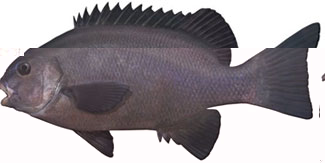Fishing For
Top Sites
 Blackfish (Tautog)
Blackfish (Tautog)
Blackfish, also known by its Native American name Tautog, is found from Nova Scotia to South Carolina. They are most abundant from Cape Cod to the Chesapeake Bay.
Blackfish live both in near shore coastal waters as well as offshore ocean waters. They prefer structured habitats and are frequently found near piers, breakwaters, artificial reefs and areas with rocky bottoms. They are distinguished by their large lips and teeth, which are used to catch and eat their favorite foods, shellfish and crabs.
Blackfish have a strong affinity for their chosen home site, and adults only travel about one-third mile in search of food each day. In the spring when water temperatures approach 50°F, blackfish migrate inshore to reproduce or spawn. They remain in waters near the shore throughout the summer. As the water temperature begins to drop again toward 50°F in the fall, blackfish move back to deeper ocean waters for the winter.
Blackfish can grow up to 25 pounds, but smaller fish up to three pounds are more typical. When not feeding during the day and when resting at night, tautog often become so docile that they appear to be sleeping and can be touched by divers. Blackfish is primarily harvested by recreational anglers who according to the Atlantic States Marine Fisheries Commission have accounted for about 90% of the catch since 1980. Most commercial landings have been by otter trawl, fish traps and gill nets. Tautog are also caught commercially by hook-and-line gear and as bycatch in lobster or other pots.
Blackfish has a relatively firm white meat, which makes it well suited for a variety of different preparation methods including fish stews and chowders. In fact in many seaside towns blackfish is the traditional ingredient in fish chowder. "It's a mild tasting fish somewhat like sea bass," says George Leeman of the Shinnecock Fish Dock. Blackfish can be used in almost any recipe that calls for lean white flesh fish with a mild taste like cod, sea bass, tilefish or halibut. Baking, broiling or sautéing are all good choices for this versatile fish.


